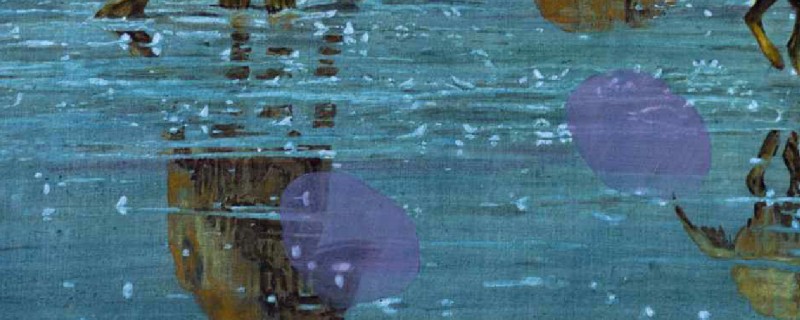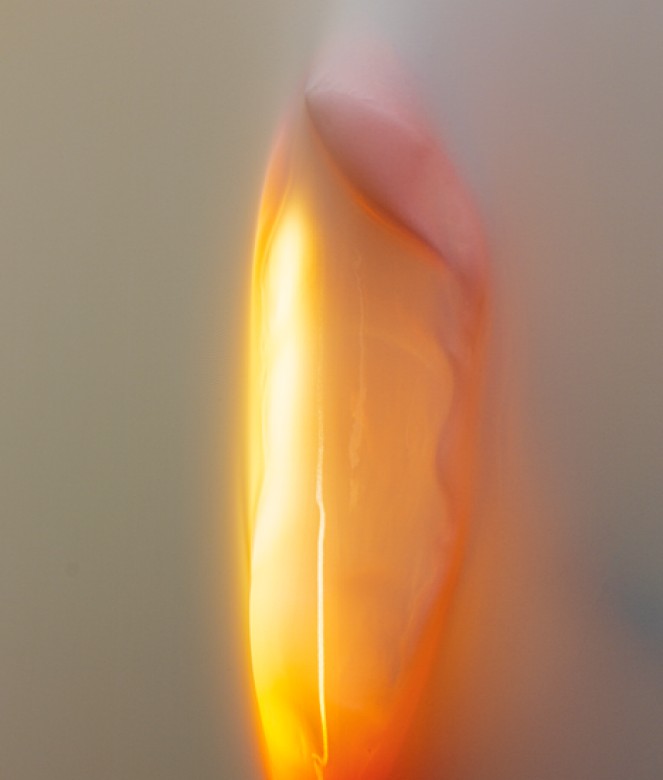‘You could say that materials are the third member of Pakui Hardware’, say Neringa Černiauskaitė and Ugnius Gelguda, the Lithuanian artists behind the duo. Hand-blown glass, silicone films and flexible membranes are part of their visual vocabulary — a kind of pictographic script. These elements are set in motion, animated and brought to life by compressed air. The movement, externally controlled and devoid of will, repeatedly pushes through limits of the light, flexible ‘barrier’. This is done without permanently altering its structure — the fabric expands and contracts with each impulse.
Crossing the eponymous thresholds results in a significant change — in economics, for example, it refers to thresholds beyond which the functioning of an entire system, the behaviour of a market or a policy, changes. As characteristic of Pakui Hardware’s work, the title here is polysemic. It may also allude to traditional Lithuanian culture, in which the threshold (Lithuanian: slenkstis) was considered both sacred and dangerous, a belief reflected in various customs and superstitions. In the field of education, however, threshold concepts are discipline-specific ideas or issues that open up new cognitive perspectives, leading to a transformation of skills, knowledge and attitudes.
- Threshold One
The artists of Pakui Hardware are not only inspired by thinkers in sociology, medicine and philosophy, but can also be seen as thinkers themselves. They construct their own ‘arguments’ using the aforementioned materials — glass, latex, polyamide, steel, air and more — which they shape and juxtapose to create meaningful relationships. This text serves as a guide to these specific meanings.
Organic sculptural forms associated with the acquisition of knowledge have a long history. From antiquity to the twentieth century, they were carried forward by, among others, the German art historian Aby Warburg. In his famous Mnemosyne Atlas he referred to the ancient practice of hepatoscopy — divination through the liver of a sacrificial animal. He included photographs of clay sculptures representing internal organs, which were used as teaching aids for apprentice diviners. These ceramic models were realistic — life-sized and anatomically detailed. Their surfaces were covered with inscriptions, allowing the student to ‘read’ the desired information from specific areas of the organ.
Although Pakui Hardware do not mark their sculptures with inscriptions, they create them with a specific intention, drawing on associations with the organisation of social life and its systems of control, often using analogies drawn from the workings of the human body. Among the concepts they explore are those of the nervous system, genetics, and the immune system.
In Burn, shown at carlier | gebauer in Madrid, and Inflammation, presented at the Lithuanian National Museum of Art in Vilnius and later at the Venice Art Biennale, the artists addressed the crises of health and the environment. They were interested in how an organism — both on a human and planetary scale — responds to inflammation, and how this condition can be alleviated. Their inspiration came from Rupa Marya and Raj Patel’s book, which explores the relationship between health and socio-climatic conditions: ‘Your body is inflamed. . . . Your body is part of a society inflamed. . . . As a consequence, the planet is inflamed.’[1] The glowing, irregularly shaped glass components of Pakui Hardware’s sculptures echoed the visible symptoms of inflammation, such as tissue redness.
Since 2023, another key theme in their work has been the concept of immunity, understood in the context of security and surveillance systems — on both an individual and societal level. If, as Mark Neocleous[2] has suggested, the immune system can be treated as a model for understanding the relationship between the body (biological or political) and sovereignty, then identity becomes the fundamental point of reference — both for citizens and for statehood. Organisms recognise and distinguish the self from the other. And any attempt to test these boundaries strains the body’s resilience.
Both metaphors — inflammation and the immune system — equate the physical with the political. Pakui Hardware’s projects based on these metaphors reflect the artists’ ongoing interest in the contemporary humanities, particularly the concept of transcorporeality. This term, introduced by Stacy Alaimo[3], highlights the idea that we cannot perceive ourselves as separate from nature, but as part of it. The boundaries between our bodies and the outside world are fluid. Chemicals, toxins and other environmental elements can enter our systems and affect our health and well-being.
- Threshold Two
What is the point of comparing artists? Does it make sense to look for connections between practices from different decades and cultural contexts? What is more important in contemporary art — the context specific to time and place, or a focus on the universal? The similarities between the sculptures and installations of Pakui Hardware and the artists mentioned below lie in a shared interest in the material, the corporeal, the organic and the technologically evolved.
As part of their aforementioned project Inflammation, the duo Pakui Hardware incorporated works by Marija Teresė Rožanskaitė (1933–2007) into their multi-part installation — a gesture of respect to the artists who came before them. Rožanskaitė was chosen as a predecessor for her series of works depicting healthcare spaces and hospital radiology laboratories. Like Rožanskaitė, the sculptor Helen Chadwick (1953–1996) also explored medical imagery. Both artists drew on the visual language of biology and medicine, including cellular imagery, organic forms and bodily fluids. In Viral Landscapes (1988–1989), Chadwick combined microscopic images of her own cells with altered landscapes, exploring the immune system, disease and the body’s interaction with the environment.
When the body in the works of Rožanskaitė, Chadwick and also Alina Szapocznikow (1926–1973) is understood as a political body, its interpretation shifts — it becomes a site of struggle, a tool of resistance or a means of negotiating power and identity. Their works cease to be mere experiments in materiality and corporeality and begin to speak of structures of control, the disciplining of bodies, oppression, power and individual autonomy.
- Threshold Three
Among the works presented at Zachęta, one such ‘anchor’ in the field of art is Zilia Sánchez Domínguez (1926–2024), who used canvas stretched over wooden frames to create minimalist reliefs. These abstract forms were intended to evoke parts of the body, giving the illusion that they were made of delicate skin. The sense of organicity was created by the interplay of light and shadow across the surface, which was shaped by the artist. Such experimentation with the tension and texture of the surface is also central to Pakui Hardware’s practice.
Aleksandra Kasuba (1923–2019), artist and environmental architect, also from Lithuania, who settled in the United States in 1947, is the undisputed master of the design of large-scale environments — so-called habitats — for the Lithuanian artists. In New York in the late 1960s, she became involved with the interdisciplinary collective Experiments in Art and Technology (E.A.T.). At a group exhibition in 1968, she presented Gateway, her first kinetic sculpture, made of plexiglass and paired with a halogen lamp. Sensors and a mechanical system controlled the movement of the light source, causing the Plexiglas to cast dynamic shadows on the wall. From 1970 onwards, Kasuba concentrated on working with stretched thermal insulation fabrics[4]. She used them to create ‘flexible’ dwellings, taking full advantage of the material’s malleability and elasticity, which allowed for smooth, rounded, large-scale surfaces. These technical membranes, carefully shaped and illuminated, invited the public into immersive experiences of merging with an ambiguous body — explored from both the outside and the inside.
A body without a fixed boundary or ‘shell’ — acting instead as a dynamic surface of contact with the world — also appears in the work of Pakui Hardware. The artists are inspired by the concept of viscous porosity[5], a term coined by ecofeminist Nancy Tuana to describe the mutual permeability of humans and the environment[6]. Through this lens, we can understand the simultaneously thin and resilient fabric used in Thresholds. The elasticity with which it expands under the pressure of a mechanical arm and then returns to its original shape is a defining characteristic of a membrane. This permeable barrier separates while allowing contact. Skin is such a membrane — an active organ that protects, regulates, filters and allows passage. As Stacy Alaimo might put it, the world enters us through our skin, and we are in constant exchange with it.
[1] Rupa Marya, Raj Patel, Inflamed: Deep Medicine and the Anatomy of Injustice, New York: Farrar, Straus and Giroux, 2021, p. 4.
[2] Mark Neocleous, The Politics of Immunity: Security and the Policing of Bodies, London–New York: Verso, 2022.
[3] Stacy Alaimoworks in the fields of American literature, ecocultural theory, environmental humanities, gender theory, and new materialism; see Bodily Natures: Science, Environment, and the Material Self, Bloomington: Indiana University Press, 2010.
[4] She created her first fabric environment for the group exhibition Contemplative Environments at the Museum of Contemporary Crafts in New York, where artists presented a range of optical and sound-based projects, installations with fresh flowers and other spatial experiments.
[5]The term refers to the ‘viscosity’ of a substance — a concept in Newtonian physics that describes how much a material retains its shape. The more viscous the substance, the more tightly its constituent particles hold together. Viscosity has been introduced into the philosophy of new materialism and the social sciences; see https://newmaterialism.eu/almanac/v/viscosity.html, accessed 7 April 2025.
[6] Nancy Tuana, ‘Viscous Porosity: Witnessing Katrina’, in Material Feminisms, ed. Stacy Alaimo, Susan Hekman, Bloomington: Indiana University Press, 2008, pp. 188–213.
-
25.04 – 06.07.2025Pakui Hardware. Progi / Thresholds
Litewski duet artystyczny Pakui Hardware, tworzony przez Neringę Černiauskaitė i Ugniusa Gelgudę, prezentuje w Warszawie swoje nowe rzeźby kinetyczne. Wykonane ze stali, szkła, silikonu oraz elastycznej tkaniny poruszają się w jednostajnym rytmie, tworząc wrażenie autonomicznych podmiotów.
Zachęta – Narodowa Galeria SztukiZachęta
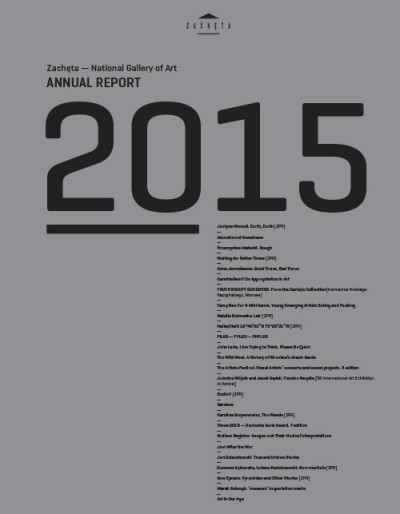 foldery / tekstyAnnual report 2015
foldery / tekstyAnnual report 2015 foldery / tekstyZrób to sam z ZachetąMateriały edukacyjne do wystawy Historie ucha
foldery / tekstyZrób to sam z ZachetąMateriały edukacyjne do wystawy Historie ucha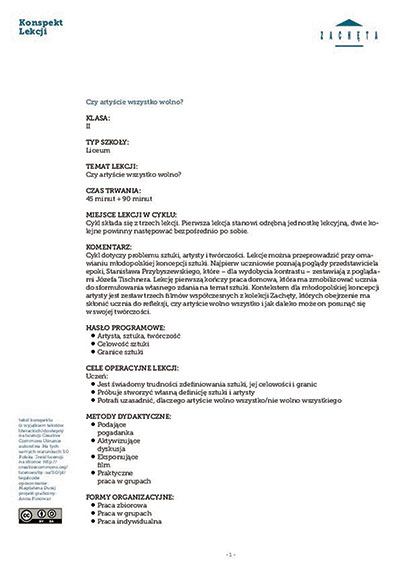 foldery / tekstyCzy artyście wszystko wolno?Konspekt lekcji j. polskiego i WOK dla liceum
foldery / tekstyCzy artyście wszystko wolno?Konspekt lekcji j. polskiego i WOK dla liceum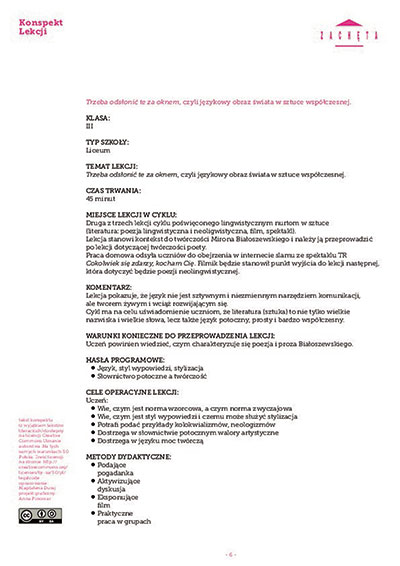 foldery / tekstyJęzykowy obraz świata w sztuce współczesnej_1Konspekt lekcji j. polskiego dla liceum
foldery / tekstyJęzykowy obraz świata w sztuce współczesnej_1Konspekt lekcji j. polskiego dla liceum foldery / tekstyJęzykowy obraz świata w sztuce współczesnej_2Konspekt lekcji j. polskiego dla liceum
foldery / tekstyJęzykowy obraz świata w sztuce współczesnej_2Konspekt lekcji j. polskiego dla liceum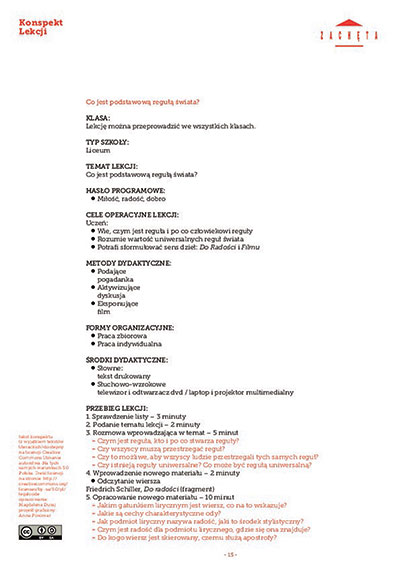 foldery / tekstyCo jest podstawową regułą świataKonspekt lekcji j. polskiego i WOK dla liceum
foldery / tekstyCo jest podstawową regułą świataKonspekt lekcji j. polskiego i WOK dla liceum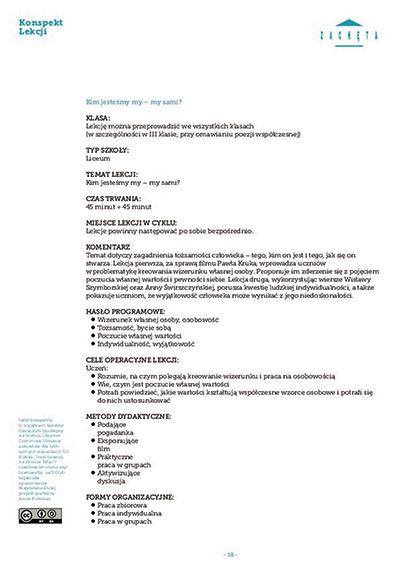 foldery / tekstyKim jesteśmy my - my samiKonspekt lekcji j. polskiego i WOK dla liceum
foldery / tekstyKim jesteśmy my - my samiKonspekt lekcji j. polskiego i WOK dla liceum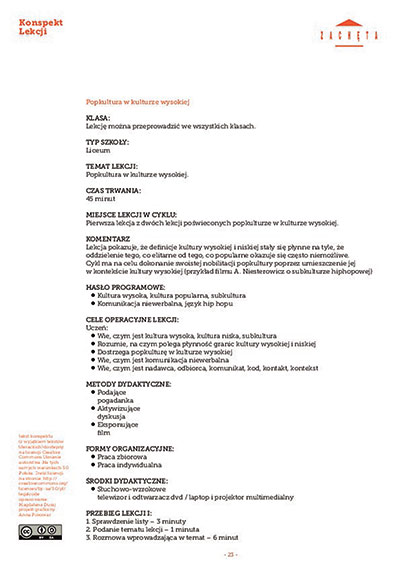 foldery / tekstyPopkultura w sztuce wysokiej_1Konspekt lekcji j. polskiego i WOK dla liceum
foldery / tekstyPopkultura w sztuce wysokiej_1Konspekt lekcji j. polskiego i WOK dla liceum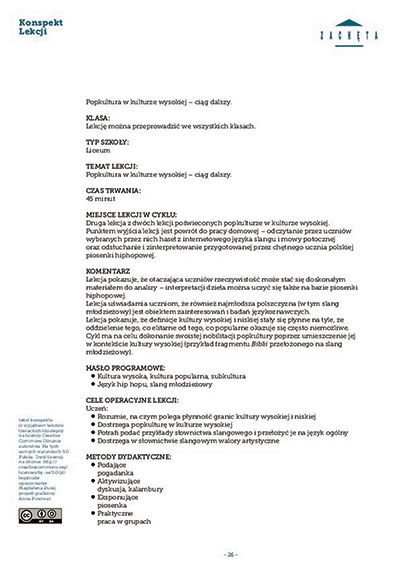 foldery / tekstyPopkultura w sztuce wysokiej_2Konspekt lekcji j. polskiego i WOK dla liceum
foldery / tekstyPopkultura w sztuce wysokiej_2Konspekt lekcji j. polskiego i WOK dla liceum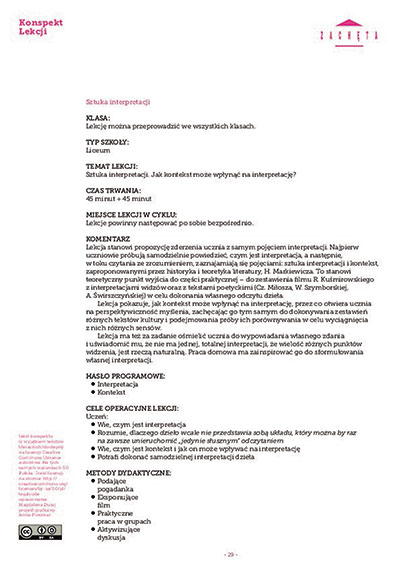 foldery / tekstySztuka interpretacjiKonspekt lekcji j. polskiego i WOK dla liceum
foldery / tekstySztuka interpretacjiKonspekt lekcji j. polskiego i WOK dla liceum
Dziękujemy za rejestrację!
Na Twój adres e-mail wysłaliśmy link z potwierdzeniem rejestracji.
Kliknij w podany wewnątrz link żeby w pełni aktywować konto.
Rejestrując się w serwisie możesz dodawać ważne dla Ciebie wydarzenia i wystawy do swoich ulubionych. Do ulubionych możesz również dodać obiekty z kolekcji, oraz mediateki i publikacji, które udostępniamy na otwartej licencji Creative Comons. Dzięki temu możesz pobierać publikacje, książki, filmy i wiele innych.
Za chwilę nastąpi przekierowanie na stronę główną
